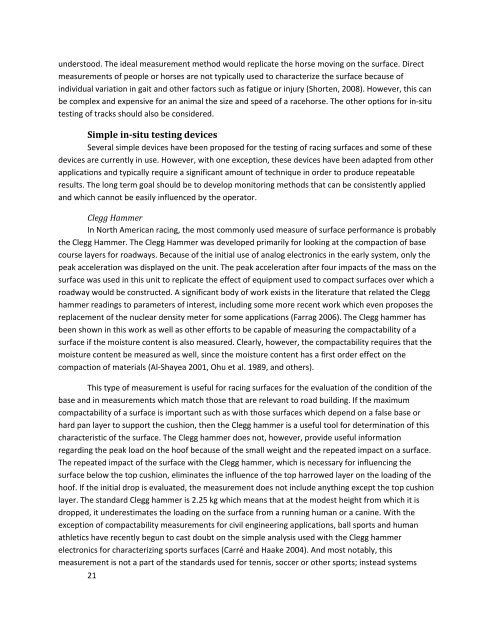Retired Racehorses
tfrr_reportandappendicesfinal
tfrr_reportandappendicesfinal
- No tags were found...
Create successful ePaper yourself
Turn your PDF publications into a flip-book with our unique Google optimized e-Paper software.
understood. The ideal measurement method would replicate the horse moving on the surface. Direct<br />
measurements of people or horses are not typically used to characterize the surface because of<br />
individual variation in gait and other factors such as fatigue or injury (Shorten, 2008). However, this can<br />
be complex and expensive for an animal the size and speed of a racehorse. The other options for in‐situ<br />
testing of tracks should also be considered.<br />
Simple insitu testing devices<br />
Several simple devices have been proposed for the testing of racing surfaces and some of these<br />
devices are currently in use. However, with one exception, these devices have been adapted from other<br />
applications and typically require a significant amount of technique in order to produce repeatable<br />
results. The long term goal should be to develop monitoring methods that can be consistently applied<br />
and which cannot be easily influenced by the operator.<br />
Clegg Hammer<br />
In North American racing, the most commonly used measure of surface performance is probably<br />
the Clegg Hammer. The Clegg Hammer was developed primarily for looking at the compaction of base<br />
course layers for roadways. Because of the initial use of analog electronics in the early system, only the<br />
peak acceleration was displayed on the unit. The peak acceleration after four impacts of the mass on the<br />
surface was used in this unit to replicate the effect of equipment used to compact surfaces over which a<br />
roadway would be constructed. A significant body of work exists in the literature that related the Clegg<br />
hammer readings to parameters of interest, including some more recent work which even proposes the<br />
replacement of the nuclear density meter for some applications (Farrag 2006). The Clegg hammer has<br />
been shown in this work as well as other efforts to be capable of measuring the compactability of a<br />
surface if the moisture content is also measured. Clearly, however, the compactability requires that the<br />
moisture content be measured as well, since the moisture content has a first order effect on the<br />
compaction of materials (Al‐Shayea 2001, Ohu et al. 1989, and others).<br />
This type of measurement is useful for racing surfaces for the evaluation of the condition of the<br />
base and in measurements which match those that are relevant to road building. If the maximum<br />
compactability of a surface is important such as with those surfaces which depend on a false base or<br />
hard pan layer to support the cushion, then the Clegg hammer is a useful tool for determination of this<br />
characteristic of the surface. The Clegg hammer does not, however, provide useful information<br />
regarding the peak load on the hoof because of the small weight and the repeated impact on a surface.<br />
The repeated impact of the surface with the Clegg hammer, which is necessary for influencing the<br />
surface below the top cushion, eliminates the influence of the top harrowed layer on the loading of the<br />
hoof. If the initial drop is evaluated, the measurement does not include anything except the top cushion<br />
layer. The standard Clegg hammer is 2.25 kg which means that at the modest height from which it is<br />
dropped, it underestimates the loading on the surface from a running human or a canine. With the<br />
exception of compactability measurements for civil engineering applications, ball sports and human<br />
athletics have recently begun to cast doubt on the simple analysis used with the Clegg hammer<br />
electronics for characterizing sports surfaces (Carré and Haake 2004). And most notably, this<br />
measurement is not a part of the standards used for tennis, soccer or other sports; instead systems<br />
21


